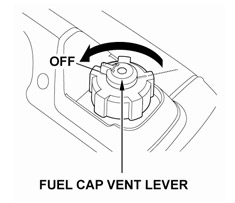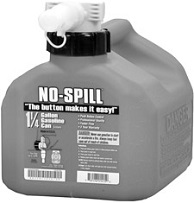Avoiding Fuel-Related Problems EU1000i • EU2000i • EU3000i Handi
Follow These Five Steps to Prevent Most Fuel-Related Problems
- Do not use fuel containing more than 10% ethanol in your Honda generator.. Ethanol is corrosive and also quickly attracts water from the air into the fuel. This can cause starting or running problems or, in some cases, damage to your engine’s fuel system.
- Add fuel stabilizer to your portable fuel container. Since you don’t know how long fuel will remain in your portable fuel container, it is recommended that you always add fuel stabilizer according to the manufacturer’s instructions when you fill the container with fresh fuel.
- When the generator is not in use. Always close the fuel cap vent. Store the generator away from direct sunlight in a cool, dry area if possible Fuel will deteriorate faster when exposed to air and the heat from sunlight.
-
If you do not plan to operate the generator frequently (less than once a month), drain the carburetor following the directions shown in the owner’s manual. The properties of gasoline can quickly lead to stale fuel, causing starting or running problems.
The fuel in the carburetor float bowl will deteriorate faster than fuel in the tank due to small fuel volume, proximity to engine heat, or being open to the atmosphere. - If you do not plan to use your Honda generator for more than 1 year, drain the fuel tank and carburetor following the storage procedure in your owner’s manual. Even treated gasoline (with fuel stabilizer) left in the engine’s fuel system can deteriorate during long term storage, causing starting or running problems and, in some cases, damage to the fuel system.
Refer to your generator's Owner’s Manual for additional information. If you do not have an owner's manual, you can download the manual here.
Storing Your Honda EU1000i, EU2000i, or EU3000i Handi for More Than 4 Weeks (30 days)
Storage Time: 1 to 2 months
-
 Fill the tank with fresh fuel with added fuel stabilizer. If the tank is only partially filled,
air in the tank will promote fuel deterioration during storage.
Fill the tank with fresh fuel with added fuel stabilizer. If the tank is only partially filled,
air in the tank will promote fuel deterioration during storage.
-
If adding a fuel stabilizer to the fuel for the first time, run the engine outdoors for 10 minutes to be sure the treated gasoline has replaced the untreated gasoline throughout the fuel system. Note:
- All stabilizers have a shelf life, and their performance will deteriorate over time.
- Fuel stabilizers will not reconstitute stale fuel.
-
Stop the engine and close the fuel cap vent. Store your generator and fuel storage container in a cool dry area.
Storage Time: 2 to 12 months (or less than once a month operation)
- Drain the carburetor following the directions shown in your owner’s manual.
- Close the fuel cap vent. Store in a cool dry area.
Storage Time: More than 1 year (long term storage)
- Drain the fuel tank and carburetor following the instructions in your owner’s manual.
- Close the fuel cap vent. Store in a cool dry area.
Fuel in Your Portable Fuel Container
It is recommended that you use a self-sealing portable fuel container for refueling your generator. This will help to prevent fuel vapors from escaping and also prevent moisture from being drawn back into the container. This, along with adding fuel stabilizer, will substantially help to keep the fuel volatile and help prevent fuel-related problems.

Honda Fuel Stabilizer, 8oz
PN 08732-0800

Portable Fuel Container
PN 06176-1415-C6
If stabilized fuel has been in your portable storage container for 12 months, the Environmental Protection Agency (EPA) suggests adding the fuel to your car’s gas tank provided your car’s gas tank is fairly full. Add fuel stabilizer to the portable fuel container when you refill it.








